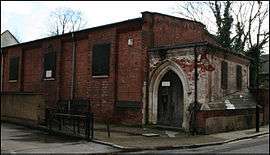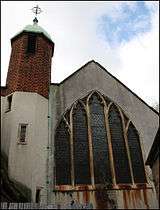Blackwing Studios

Blackwing Studios was an English recording studio, most notable for early Depeche Mode and Yazoo recordings in the early 1980s.
Background

The Blackwing Studios complex was housed inside a deconsecrated church in South-East London. All Hallows church was partly destroyed during The Blitz in 1941. After the war Southwark Cathedral retained the north aisle and carried on using it as a temporary church. The destroyed south aisle was later turned into gardens and maintained by local residents from 1968.[1] Blackwing was started by Eric Radcliffe, who worked on most of the early Mute Records recordings alongside Daniel Miller.[2] Daniel Miller had discovered Blackwing when recording the Silicon Teens album. He required a studio with a big control room where he could set up all his synthesisers.[2] At the rear of the church building was a bell tower that was used for storing master tapes.[3] Daniel Miller carried on using Blackwing to record other new Mute Records artists. The first Depeche Mode album, Speak and Spell, was recorded at Blackwing using a TEAC eight track recorder. The album was engineered by John Fryer.[4] Yazoo named one of their albums after the studio, Upstairs at Eric's due to the main Blackwing studio being above Splendid Studios located downstairs.[5] When Clarke initially came to Blackwing to record with Yazoo he found that the studio was fully booked; Depeche Mode were recording their new album. He had the choice of recording at 4am during studio downtime, or building another studio. This is how Splendid Studios came about. It was a private studio below the commercial Blackwing studios upstairs.[6] After the split of the band Yazoo, Vince Clarke decided he wanted to remain in the music industry. His initial enterprise after Yazoo was the formation of his own record label called Reset Records. The enterprise was a joint effort with Eric Radcliffe, the idea being to sign and produce new acts from their independent Splendid Studios, underneath the Blackwing complex. The recordings were then licensed to RCA Records for release.[7] Blackwing Studios closed down in September 2001 and the building has been empty ever since, but the church building and gardens are still there. However, this may soon not be the case as Southwark Council have been submitting plans since 2005 to redevelop the site with a four-storey development of private flats.[8]
Studio Equipment
When Eric Radcliffe opened Blackwing he initially used an eight track TEAC for recording artists; this was later replaced by a 16 track machine. A second recorder was acquired and locked together with the initial machine giving Blackwing 32 tracks of recording. This system was used for many early recordings by Yazoo and Depeche Mode. The system was eventually rationalised when two 24 track machines were purchased; one for Blackwing and one for Splendid Studios, downstairs. Blackwing used an Amek 2500 mixing desk which was modified to work with electronic instruments. All the equipment at Blackwing and Splendid Studios was designed to be patchable through patch bays; none of the effects units was hardwired.[6] Vince Clarke installed a Fairlight CMI into Blackwing, which he had bought before the Yazoo tour, and used it on tracks like Never Never by The Assembly. Due to the low bandwidth that the Fairlight produced he began using the Synclavier, which used FM synthesis. This led in 1984 to Clarke’s purchase of a Yamaha DX7; he also updated the sound cards in the Fairlight to create a fuller sound. The Fairlight was used to sample sounds of Clarke smashing all sorts of wood, china and glass that were found when demolishing the lower part of the church to build Splendid Studios.[6] Blackwing used a range of quality reverberation including an AMS RMX, Lexicon 224 and 224X and a Quantec Room Simulator. Recordings at Blackwing also used natural reverb from a long corridor that still retained the stonework from the original war damaged church. Above the studio there was a natural echo chamber that lay under the church roof. Eric Radcliffe left the echo chamber when designing the studios as it seemed a waste removing it.[6]
Depeche Mode
One of the first tracks Depeche Mode recorded at Blackwing was "Dreaming of Me", after being decided it would be the first Depeche Mode single.[2] At the time Vince Clarke was unemployed so he spent most of the daytime in the studio with Daniel Miller. Miller would give Clarke help and advice on how to get sounds, use studio technology and arrange songs. Then later in the afternoon Martin Gore and Andrew Fletcher would arrive from their day jobs to record melody parts.[9] After the recording of Speak & Spell Vince Clarke left the band, but carried on recording at Blackwing. In late 1981 the three remaining members of Depeche Mode returned to Blackwing and recorded the single "See You".[10] The track was the first Depeche Mode track to use a Roland MC-4 sequencer, which made the core sound to the track.[11] It would also be the first track recorded without Clarke.
Notable Recordings at Blackwing
- Silicon Teens - Music for Parties (Mute Records) 1980
- Fad Gadget - Fireside Favourites (Mute Records) 1980
- Depeche Mode - Speak & Spell (Mute Records) 1981
- Fad Gadget - Incontinent (Mute Records) 1981
- Boyd Rice & Frank Tovey - Easy Listening for the Hard of Hearing (Mute Records) Recorded 1981
- Duet Emmo - Or So It Seems (Mute Records) Recorded 1981 / 1982
- Yazoo - Upstairs at Eric's (Mute Records) 1982
- Depeche Mode - A Broken Frame (Mute Records) 1982
- Fad Gadget - Under the Flag (Mute Records) 1982
- Cocteau Twins - Garlands (4AD) 1982
- Yazoo - You and Me Both (Mute Records) 1983
- Dead Can Dance - Dead Can Dance (4AD) 1984
- Clan of Xymox - Medusa (4AD) 1986
- Lonely Is an Eyesore (4AD) 1987
- Nine Inch Nails - Pretty Hate Machine (TVT Records) 1989
- Ride - Nowhere (Creation Records) 1990
- My Bloody Valentine - Loveless (Creation Records) 1991
- Pixies - Trompe le Monde (4AD) 1991
- The God Machine - Scenes from the Second Storey (Fiction Records) 1991
- Stereolab - Peng! (Too Pure) 1992
- Django Bates - Quiet Nights (Screwgun Records) 1998
- The Mutton Birds - Rain, Steam and Speed (Shhhh Records) 1998
- Stereolab - Cobra and Phases Group Play Voltage in the Milky Night 1999 (Elektra Records/Duophonic Records)
External links
Footnotes
- ↑ London SE1 Retrieved on January 29, 2010
- 1 2 3 Page 27, Depeche Mode Biography, Steve Malins
- ↑ Erasure Official Site Retrieved on February 26, 2010
- ↑ Sound on Sound Retrieved on January 29, 2010
- ↑ Page 28, Depeche Mode Biography, Steve Malins
- 1 2 3 4 E&MM Magazine March 1984
- ↑ Erasure Official Site Archived March 16, 2010, at the Wayback Machine. Retrieved on January 29, 2010
- ↑ Save All Hallows Retrieved on March 4, 2010
- ↑ Page 30, Depeche Mode Biography, Steve Malins
- ↑ Page 43, Depeche Mode Biography, Steve Malins
- ↑ Page 139, Stripped: Depeche Mode, Jonathon Miller
Coordinates: 51°30′12″N 0°05′52″W / 51.503221°N 0.097817°W